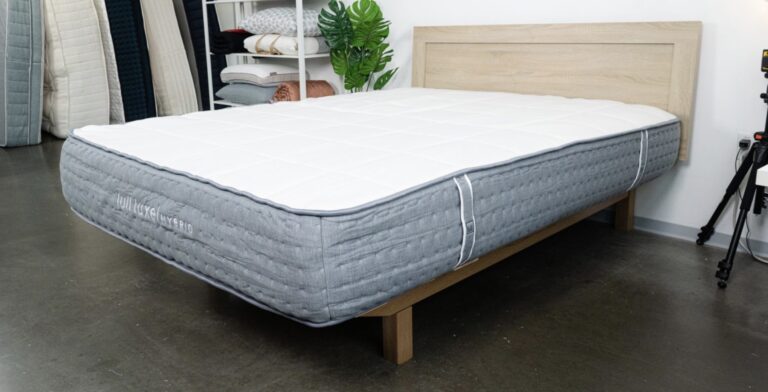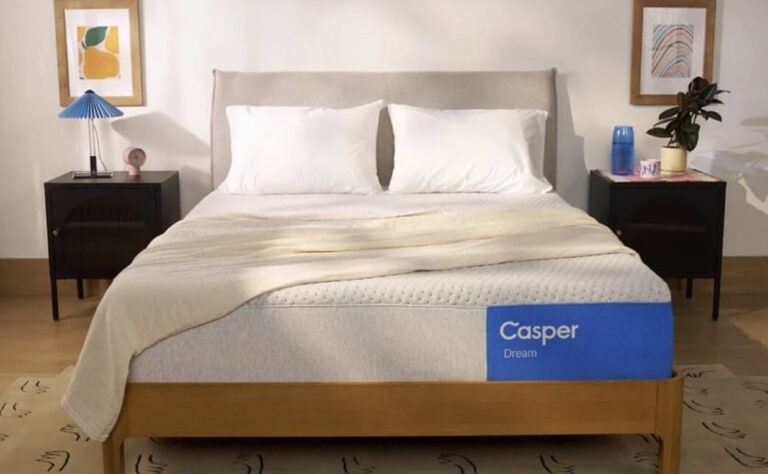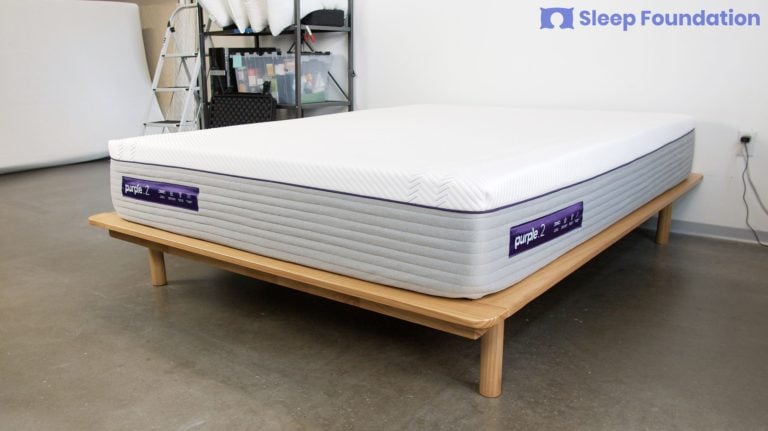When you buy through our links, we may earn a commission. Products or services may be offered by an affiliated entity. Learn more.
Brooklyn Bedding vs. Tuft & Needle Mattress Comparison
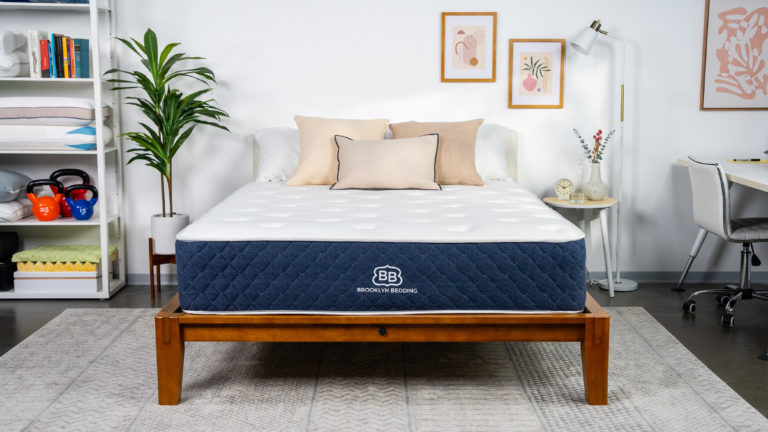
Brooklyn Bedding Signature Hybrid
Bottom Line
The Brooklyn Bedding Signature Hybrid combines foams with a strong base of coils to provide a blend of support and cushioning.
25% off sitewide. Code: PRESDAY25
Full Mattress ReviewVS
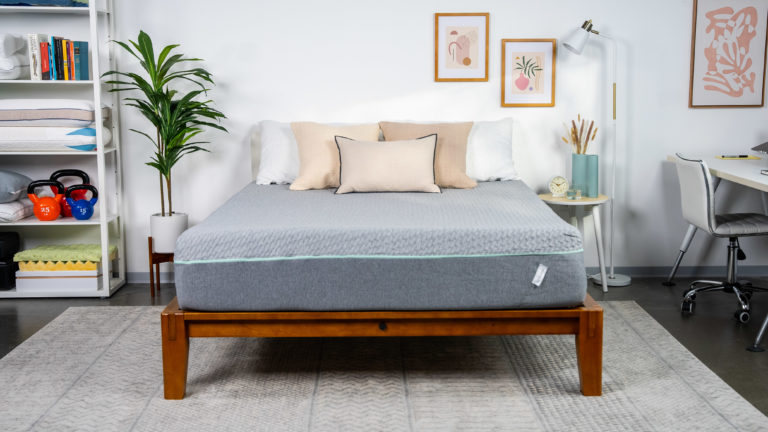
Tuft & Needle Original
Bottom Line
The Tuft & Needle uses bouncier foams that are engineered to reduce heat retention to relieve pressure and stay cool through the night.
15% off mattresses
Full Mattress ReviewIf you’re shopping for a new mattress, you may already be familiar with Brooklyn Bedding and Tuft & Needle. Both are well-known direct-to-consumer companies that produce sleep products, including sheets, pillows, foundations, and mattresses.
Brooklyn Bedding’s mattress lineup includes six main models: the Signature, the Aurora, the Spartan, and the Bowery Hybrid. Tuft & Needle has three mattress options: the Original, the Mint, and the Hybrid. Both companies have both hybrid and all-foam models.
The firmness options vary between the two brands. Brooklyn Bedding has a wider range of firmness options, which include medium soft (4), medium firm (6), and firm (7-8). Tuft & Needle has two firmness options: medium (5) and medium firm (6). The mid-range firmness options offered by both brands can accommodate most sleepers, but people who prefer a mattress that is softer or firmer than average may favor Brooklyn Bedding’s options.
Shoppers may notice some similarities between the Brooklyn Bedding and the Tuft & Needle mattresses, but the differences between the two brands may ultimately play a role in determining which option is best for you. In this review, we’ll go over sizing, construction, materials, performance, pricing, and policies to help you make the difficult decision between Brooklyn Bedding vs. Tuft & Needle.
Quick Look
$699 – $1,586
$995 – $1,595
Medium Soft (4), Medium (5), Medium Firm (6), Firm (7), Firm (8)
Medium (5), Medium Firm (6)
- Multiple models and firmness options
- Notable pressure relief
- Balanced features
- Temperature-regulating gel- and graphite-infused polyfoam
- Easy for most sleepers to move on
- Mid-range firmness
- 120 nights (30-night requirement)
- Lifetime, limited
- 100 nights
- 10-Year, Limited
- A+
- A+
Sizing and Weight Options
The size, height, and weight of your mattress influence so much more than what sort of foundation and sheets you need. It can also play a role in how comfortable the mattress feels, how well it fits into your room, and how convenient it is.
Each person has unique comfort preferences, which often relate to the size, height, and weight of the mattress. Size is particularly important for people who sleep with partners since it influences how much space they have to move around. Mattress height may make it easier or more challenging to get into or out of bed, and it can impact how supportive a mattress feels. Heavier individuals frequently prefer thicker models. The mattress’s weight could affect how secure the mattress feels on its frame, which may be important for amorous activity.
Your allotted space is another key factor to consider when selecting the size and height of the mattress. A mattress that is too large for the room may be challenging to navigate around when making the bed. Similarly, if you have low ceilings or a bunk bed, lower-profile models may fit better in the space.
The mattress size and weight can also shape its convenience. Many mattresses are designed to be rotated frequently for more even wear, and lighter and/or smaller mattresses are generally easier to move.
Brooklyn Bedding
Tuft & Needle
Height
11.75″Size Options
Twin, Twin XL, Short Full, Full, Short Queen, Queen, King, California King, Split California KingHeight
9.5?Size Options
Twin, Twin XL, Full, Queen, King, California KingHeight
13.25″Size Options
Twin, Twin XL, Full, Short Queen, Queen, King, California King, Split California KingHeight
12″Size Options
Twin, Twin XL, Full, Queen, King, California KingHeight
13″Size Options
Twin, Twin XL, Full, Queen, King, California King, Split California KingHeight
12″Size Options
Twin, Twin XL, Full, Queen, King, California KingBloom Hybrid
Height
11″, 14″Size Options
Twin, Twin XL, Full, Queen, King, California KingHeight
10″Size Options
Twin, Twin XL, Full, Queen, King, California KingBecause Brooklyn Bedding has six mattress models compared to Tuft & Needle’s three, there is more variation between weights and heights of its mattresses.
The queen size of the Brooklyn Bowery weighs just 70 pounds, while the Brooklyn Bloom comes in at 120 pounds. Tuft & Needle’s lightest model, the Original, totals 72 pounds. The Hybrid is Tuft & Needle’s heaviest option, weighing 112 pounds. Variations in the materials and construction cause the weight differences between brands and models.
Both companies produce 10-inch mattress models, which are their thinnest options. Tuft & Needle also produces two 12-inch models, while Brooklyn Bedding makes an 11 inch model and two 13.5-inch options. Individuals who prefer a thicker mattress may like the Brooklyn Aurora or the Brooklyn Spartan, which are the tallest mattresses by either brand.
Brooklyn Bedding and Tuft & Needle produce mattresses in the six standard sizes, but Brooklyn Bedding also makes custom sizes. This gives it an edge for customers who need a mattress with non-standard dimensions.
Construction and Materials Comparison
Hybrid, all-foam, innerspring, and latex mattresses are some of the most popular models on the market today. Hybrid models combine foam and coils, all-foam models use layers of foam, innerspring models are made up primarily of springs, and latex models use natural or synthetic latex.
Several types of foam can be used in a mattress, and each variety has some potential benefits and drawbacks. Memory foam is popular for its close-conforming pressure relief, though it is often slow to regain its shape, which may make it more difficult to move on. Memory foam can also trap heat, so many companies use special construction techniques and materials for cooling and breathability. Polyfoam is generally less prone to heat retention and quicker to respond to changes in pressure, but low-density polyfoam may deteriorate more quickly.
Latex foam can be used in all-foam, hybrid, or latex models. Natural latex is highly durable, tends to sleep cool, and has a springier feel than other types of foam. However, it usually carries a higher price tag and doesn’t have the same hugging sensation some sleepers enjoy from memory foam or polyfoam.
Coil layers serve as the support core for hybrid and innerspring models. Springs give a bed bounce while allowing air circulation, but they may start to creak as they age. The bounce of the coil layer could also contribute to motion transfer. However, high-quality coil systems usually give even support and lend to the mattress’s durability.
Brooklyn Bedding
The Brooklyn Signature
The Signature combines a premium feel and an affordable price. Its comfort layer is composed of TitanFlex polyfoam, while its transition layer uses VariFlex polyfoam. Both materials are engineered to strike a balance between the responsiveness of latex and the contouring of memory foam. The comfort layer of TitanFlex is also infused with gel to transfer heat away from the sleeper.
A 8-inch layer of pocketed coils serves as the support core, adding bounce and extra air circulation. The coils are encased and can move independently to reduce motion transfer. A .25-inch polyfoam layer is the base for the coil system.
The Signature is encased in a quilted cover, which provides cushioning while allowing airflow.
The Brooklyn Aurora
The Aurora uses a hybrid design and features advanced cooling technology. This luxury model starts with a woven cover. The top layer of the comfort system consists of 1.5 inches of polyfoam. Both the cover and the top comfort layer include a phase-change material engineered to help the sleeper maintain a neutral temperatureskin temperature of 88 degrees. A copper infusion in the top comfort layer also helps wick heat away from the sleeper’s body. The second comfort layer consists of 2 inches of latex-like polyfoam that gives additional contouring and responsiveness.
A 1-inch layer of memory foam serves as the transition layer. This layer gives deeper contouring while acting as a barrier between the comfort and support layers. A gel swirl in the memory foam amplifies the mattress’s cooling effect. Next, an 8-inch layer of pocketed coils supports the bed. The coils are arranged in different zones based on thickness, resulting in extra reinforcement for areas of the body where people tend to carry more weight – such as thr torso and hips – and a gentler feel for the head, shoulders, and legs. Pocketed coils also add a springy feel without a lot of motion transfer, and they allow airflow to keep the mattress cooler. The coils rest on a 1-inch layer of polyfoam that supports their compression.
The Brooklyn Spartan
The Spartan is designed with active people and muscle recovery in mind. Smart fabric in the cover is engineered to reflect the sleeper’s body energy back towards it, which is thought to improve sleep quality and promote recovery. The first layer in the comfort system is 1.5 inches of polyfoam. This layer contours to the body to relieve pressure buildup. Infusions of phase-change material and copper help cool the surface of the bed. The second comfort layer uses 2 inches of latex-like polyfoam that cradles more deeply and responds quickly to changes in pressure.
Beneath the comfort system, a 1-inch layer of memory foam helps prevent the sleeper from interacting with the firmer coil core. It is swirled with gel for additional temperature regulation. The 8-inch pocketed coil core balances bounce, breathability, and support while limiting motion transfer. A final 1-inch polyfoam layer reinforces the coil system.
The Brooklyn Bloom
The Bloom is Brooklyn Bedding’s most natural option. This latex hybrid model has a 1.25-inch quilted cover with Joma wool and organic cotton. A 3-inch layer of natural Talalay latex gives the bed a buoyant feel. Latex distributes the compression from the sleeper’s weight over a larger surface area, relieving pressure without conforming closely to the body. Because of its open cell structure, latex is also quite breathable.
Air can also flow relatively freely through the 8-inch coil core, further regulating the temperature of the sleep surface. These coils are pocketed so that minimal vibrations transfer between coils. They also give the bed more bounce. A 1-inch polyfoam base supports the springs.
The Brooklyn Bowery
The Bowery is the only all-foam option in Brooklyn Bedding’s main mattress line. A woven cover encases the mattress. The comfort layer consists of 3 inches of Energex polyfoam. This material shapes to the sleeper’s body to relieve pressure points, but it is engineered to be more responsive than memory foam. A 2-inch polyfoam transition layer acts as a buffer between the comfort system and the core. Finally, a 5-inch layer of polyfoam supports the bed.
The Brooklyn Bowery Hybrid
The Bowery Hybrid is a budget-friendly hybrid model. Its quilted top contains 1 inch of memory foam for contouring and pressure relief. Gel infused into the foam helps cool the surface. The transition layer uses 2 inches of polyfoam to help prevent the sleeper from sinking in against the firm coil core. This coil core consists of 6 inches of pocketed springs, which give the bed bounce while limiting the spread of motion. Substantial airflow through this layer helps heat dissipate. Finally, 1-inch of polyfoam acts as a supportive base for the springs.
Tuft & Needle
The Original and the Mint
Tuft & Needle’s all-foam models, the Original and the Mint, use similar materials. The Original is Tuft & Needle’s flagship model, while the Mint is a luxury option.
Both mattresses use a soft, breathable cover made of a micro polyamide and polyester blend. The Mint’s cover also has an antimicrobial protectant embedded in the fabric, and the top half can be zipped off and machine washed. The Original’s cover is non-removable.
Next, each model has a 3-inch comfort layer of proprietary T&N Adaptive polyfoam. This material is infused with graphite and gel to help regulate the temperature of the sleep surface by pulling heat away from the sleeper’s body. The Mint’s top layer includes more graphite for extra cooling. Additionally, the Mint has a 2-inch transition layer of T&N Adaptive polyfoam for extra cradling and pressure relief.
A 7-inch polyfoam core serves as the support system for both the Original and the Mint, giving the beds durable support.
The Hybrid
The Hybrid is Tuft & Needle’s only mattress that uses a coil core. It is constructed of six distinct layers.
Like the Original and the Mint, the Hybrid is encased in a cover constructed of micro polyamide and polyester. This non-removable cover is breathable so that air can circulate through to cool the mattress. A 1-inch layer of polyfoam is quilted into the cover for cushioning. This polyfoam is infused with carbon and graphite to wick away heat. Next, a 2-inch layer of T&N Adaptive polyfoam cradles the sleeper to reduce pressure points. Infusions of graphite and ceramic gel further dissipate heat.
Two transition layers help prevent sleepers from feeling the coil core. First, a 1-inch layer of microcoils give extra bounce and cradling without restricting airflow. A 1-inch layer of T&N Adaptive polyfoam supports the microcoils and separates them from the coil core.
A 6-inch layer of pocketed coils enhances the bed’s support, bounce, breathability, and motion isolation. Reinforced springs around the perimeter of the bed give the edge a sturdy feel. The springs sit on a 1-inch polyfoam base layer.
In-Depth Ratings
Each individual has their own sleep style and comfort preferences. Selecting the best mattress for you requires carefully weighing your preferences with the model’s features. The following are some of the biggest factors that may influence the sleep experience, comfort, and lifespan of the mattress. Knowing which aspects matter most to you can help you find a mattress that meets your needs.
- Durability: A mattress’s durability affects its life expectancy and its ability to resist sagging and deterioration. Mattresses that use high-quality materials tend to be more durable, but they also usually cost more. This initial investment may seem daunting for some people. However, durable models may ultimately be a better investment over their lifetimes.
- Motion Isolation: When an individual moves on a mattress, some of the vibrations from that movement may travel across the mattress. This motion transfer could be problematic for couples, especially those who tend to wake up easily. Mattresses with strong motion isolation absorb more vibrations rather than transferring them across the surface of the bed, which might help couples sleep better and awaken less often.
- Sex: Many couples prefer a mattress that is conducive to more than just sleeping. A mattress model can also impact sexual activity. Responsiveness and bounce are usually two of the highest priorities. Coil cores give a bed springiness, but they could also produce noise as they age. Some couples also like a close-conforming comfort system for traction.
- Temperature Neutrality: If you tend to sleep hot, strong temperature regulation may be a high priority. Some mattress materials are more prone to heat retention than others. Memory foam is usually most associated with trapping heat, but many mattresses use special features to counteract this effect. Breathable materials like coils, latex, and open-cell polyfoam often allow more air circulation, which helps heat dissipate.
- Pressure Relief: Sleepers who suffer from aches and pains that seem to get worse overnight might benefit from a mattress with enhanced pressure relief. Mattresses with strong pressure-relieving properties redistribute the sleeper’s weight more evenly. This relieves pressure from the key areas where it tends to accumulate, like the hips and shoulders. Contouring and conforming are usually closely associated with pressure relief, so customers may wish to look for these terms as they shop.
- Off-gassing: Like many other new products, mattresses often have an initial odor left over from manufacturing. Many mattresses ship compressed, so this smell doesn’t always have time to air out before it reaches your home. Off-gassing odors are common in mattresses that use synthetic foam, but other materials may also have a smell. While these odors are usually considered harmless for most people, individuals who are sensitive to smells may prefer a mattress less prone to off-gassing or they may choose to let their new mattress air out in a separate room before use.
- Ease of Movement: Ease of movement affects how much effort it takes to change positions or move across the surface of the bed. Individuals with mobility issues or who are prone to tossing and turning during the night may prefer a model that’s easy to move on. Close-conforming comfort layers, soft models that allow a lot of sinkage, and materials that are slow to respond to changes in pressure may restrict movement. Memory foam usually conforms quite closely and regains its shape relatively slowly, so mattresses that use a substantial layer of the material generally receive lower scores in this category. Latex and coils tend to be more responsive, so mattresses with these components usually perform well.
- Edge Support: If you like to sit or sleep near the perimeter of your mattress, edge support may be particularly important. Couples also frequently prefer a mattress with a sturdy edge because it allows them to use more of the surface. When a sleeper notices a lot of sinkage near the perimeter, they may move closer to the center of the bed to avoid feeling like they might roll off. Some mattresses, especially those with coil support layers, use dedicated edge reinforcement. Others get their edge support from their sturdy cores.
Brooklyn Bedding
Sleep Foundation Special Offer
25% off sitewide. Code: PRESDAY25
Tuft & Needle
Sleep Foundation Special Offer
15% off mattresses
In-Depth Pricing
At first glance, mattress prices can seem to vary quite wildly. They start around $300 and can easily reach prices of $3,000 or more. However, these prices are a result of several factors. Budget-friendly models often have pared-down designs, more affordable materials, and are frequently thinner. High-end models tend to use more advanced materials and are often thicker.
The material used in the mattress is one of the biggest factors in determining its price. Natural materials and technologically-advanced components often carry a higher price tag for manufacturers, and this cost is passed on to consumers. Using more materials also increases the cost for manufacturers, so larger mattress sizes and thicker models frequently cost more.
Labor costs also impact the price of the mattress. Mattresses that are made in the United States and/or use materials made in the United States often cost more due to the added expense of employing workers.
The mattresses by Brooklyn Bedding and Tuft & Needle come in a range of price points that can accommodate both budget shoppers and those seeking a higher-end option.
In general, Tuft & Needle’s prices tend to be lower than Brooklyn Bedding’s. However, this is largely because Brooklyn Bedding has several advanced hybrid options, while Tuft & Needle has just one hybrid model.
The Tuft & Needle Original is the most affordable all-foam mattress by either brand, while the Brooklyn Bowery Hybrid is the lowest-priced hybrid model.
Because people spend so much of their lives in bed, the highest-priced mattress options by Brooklyn Bedding and Tuft & Needle may also constitute a good value if they better meet the customer’s needs and preferences.
Trial, Warranty, and Delivery
Brooklyn Bedding
Sleep Trial & Returns
120 nights (30-night requirement)
Warranty
Lifetime, limited
Shipping
Free to contiguous U.S.
Tuft & Needle
Sleep Trial & Returns
100 nights
Warranty
10-Year, Limited
Shipping
Free to contiguous U.S.
Shipping
Brooklyn Bedding
Brooklyn Bedding mattresses ship free within the 48 contiguous states. Mattresses ship from Phoenix, AZ, and typically arrive within 3-4 business days. Each mattress is compressed, wrapped in plastic, packaged in a box, and shipped via FedEx.
Shipping charges apply to orders to Alaska, Hawaii, and Canada. Prices start at $125 per mattress for shipments to Alaska and Hawaii and $250 per mattress for shipments to Canada.
Tuft & Needle
Tuft & Needle mattresses ship free within the contiguous United States, and most arrive within 3-7 business days. Mattresses ship through FedEx and are typically left outside the customer’s home. Customers generally don’t need to be home for their mattress to be delivered, but you can also choose to require a signature for delivery. Each mattress ships compressed in plastic, rolled, and packed in a box.
Orders to Alaska and Hawaii typically take 7-10 days. Shipping charges for these destinations typically range from $150-$200 per mattress.
Tuft & Needle offers White Glove delivery within the contiguous United States for a non-refundable $150 fee. This service is provided through XPO, a third-party logistics company. A team will bring the new mattress into your home, set it up, and remove your old mattress.
Sleep Trial
Brooklyn Bedding
Customers have a 120-night sleep trial to try their Brooklyn Bedding mattress at home. This window includes a 30-night required break-in period before the customer can initiate a return. If you are not satisfied with your mattress during the eligible time frame, you can contact Brooklyn Bedding.
Brooklyn Bedding is committed to finding solutions, which may include working with the owner to modify the mattress, helping the customer assess their foundation, or exchanging the mattress for another model. The customer will be responsible for the price difference if they choose to exchange the mattress for a more expensive model.
If the other solutions do not work, Brooklyn Bedding also accepts returns for a full refund of the purchase price during the sleep trial.
This sleep trial is valid once per customer per calendar year.
Tuft & Needle
Tuft & Needle provides a 100-night sleep trial for customers in the United States.
If you choose to return a mattress purchased through Tuft & Needle, you can do so by contacting customer support. The company will help arrange for you to donate it to a local charity. If a suitable organization cannot be found, Tuft & Needle will arrange for a third-party service to remove the mattress at no charge. Once the mattress is donated, the customer uploads a copy of the donation receipt and Tuft & Needle processes a full refund of the purchase price. Shipping fees are non-refundable.
Customers can also exchange their mattress for a different model by calling the company. They will be charged the price difference if they select a more expensive model or receive a refund of the price difference if they choose a lower-priced option. The new product will not be eligible for a trial period.
Tuft & Needle allows one return per household per year. Mattresses sold by other vendors may have different sleep trials and return procedures and policies.
Warranty
Mattresses usually come with a warranty that protects the original mattress owner from certain potential defects. Most warranty policies are included at no charge when you buy a mattress.
Warranties vary in their length, what they cover, how the company will resolve warranty claims, and what actions by the customer void the warranty. We suggest reviewing the warranty terms before purchasing a mattress for a clearer understanding of your rights and responsibilities.
Each warranty is different, but most last for at least a few years. Covered defects typically include indentations deeper than a set measurement and cracking or splitting of the foam. Most companies will select whether to repair or replace a mattress with a qualifying defect, though some companies may charge fees for this.
Customers may be expected to follow care instructions for the mattress to qualify for warranty coverage. Leaving the mattress compressed for too long, misusing the mattress, abusing the mattress, or otherwise damaging it may void some warranty policies.
Brooklyn Bedding
The mattresses by Brooklyn Bedding have a lifetime warranty for the original purchaser. The policy covers impressions of 1 inch or more, sagging, defects that lead to splitting or cracking, and defects in the cell structure of the latex or foam. To be covered by this warranty, damage must not be due to an improper foundation and the mattress must not have been abused, misused, stained, or exposed to unsanitary conditions. Leaving the mattress compressed for 60 days or more may also void the warranty.
Brooklyn Bedding will either repair or replace mattresses it determines to have qualifying defects for free within the first 10 years. After that, owners pay a percentage of the original price to replace the mattress. This percentage increases on an annual basis.
Proof of purchase is required to make a warranty claim with Brooklyn Bedding. Additional terms and conditions apply.
Tuft & Needle
Tuft & Needle mattresses come with a 10-year limited warranty for customers located in the United States. Covered defects include indentations or sagging over .75 inches deep, flaws that lead to the cracking or splitting of the foam, and cover defects, such as the stitching unraveling. Tuft & Needle will elect to either repair or replace defective mattresses and/or mattress components.
This warranty policy is for the original purchaser who bought the mattress from an authorized distribution channel. It does not cover mattresses used for commercial purposes, nor does it cover damage that results from mishandling, poor maintenance, use of an improper foundation, or use of the mattress outside of its intended purpose.
The customer may need to furnish their receipt as proof of purchase. Additional terms and conditions apply.

Still have questions? Ask our community!
Join our Sleep Care Community — a trusted hub of product specialists, sleep health professionals, and people just like you. Whether you’re searching for the perfect mattress or need expert sleep advice, we’ve got you covered. Get personalized guidance from the experts who know sleep best.

